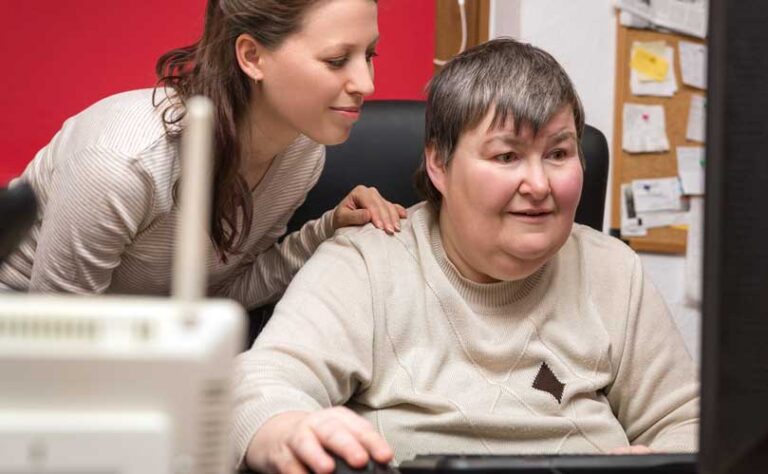If you have a loved one with autism and you’ve researched treatment options, you’ve probably heard about ABA (Applied Behavior Analysis) therapy and what it can do to help your family. One of the main reasons ABA therapy is so effective is that it’s meant to explore variables that affect behavior in order to promote behavioral changes in an appropriate manner. ABA begins with understanding certain behaviors and why they occur.
When a person has autism, it’s sometimes difficult for them to express how they’re feeling in an appropriate manner. Someone with autism doesn’t always have the tools to self-regulate their emotions and communicate in an expected way. ABA therapy starts by working to understand behaviors and what causes them. The main goal is to help people with autism gain the skills they need to cope with different situations and express themselves appropriately.
Over the course of their autism therapy, a client can learn to:
- Thrive in school, home, professional and community settings
- Learn how to ask for what they want functionally
- Communicate more effectively with others
- Learn to connect with people
- Stop self-harming, aggressive and other maladaptive behaviors
Why Is ABA Therapy Necessary?
One thing that neurotypical(non-autistic) people often forget is that tantrums are a form of communication for people who have autism; they’re expressing their feelings in one of the only ways that they know. However, tantrums are considered inappropriate behavior in society, requiring a different form of communication.
When you opt for ABA therapy, you’ll work with a board-certified behavior analyst (BCBA) and registered behavior technician (RBT) to determine the biggest areas of concern for the autistic person and family or caregivers. For example, you might find yourself having to repeatedly exit the grocery store because of inappropriate behavior by your child. Regular therapy sessions can help you understand why your child engages in undesirable behaviors and what you can do to help encourage more appropriate situational responses.
Before beginning therapy sessions, it’s a good idea to meet with a BCBA and have them observe your family in their natural environment. This helps them determine the best course of action for the client and family. If ABA therapy isn’t the best course of action for your child, a BCBA can suggest other forms of treatment to help achieve results in a manner that benefits your entire family.
How Does ABA Therapy Work?
Therapy sessions start with determining why certain maladaptive behaviors occur and what might be causing people with autism to engage in them. Undesirable behaviors often result from negative stimuli that a person who has autism doesn’t know how to cope with, such as feeling an emotion but not being able to express it properly.
One of the principles of ABA therapy involves “A-B-Cs.”
- A—Antecedent, or what occurs right before the target behavior
- B—Behavior, or the behavior we want to address
- C—Consequence, what happens afterward
When you engage in ABA therapy, a BCBA can help someone with autism learn to establish appropriate coping skills that can help them determine alternate ways to deal with situations. For example, if a person is having a disagreement with a family member, instead of yelling or running from the room, they can learn to say that they need a five-minute cool-down break to approach the situation when they feel better equipped to handle it.
ABA therapy can put an autistic person into simulated situations so they can learn to engage in appropriate behaviors at a pace that makes sense for them. Clients learn to deal with undesirable tasks in a way that’s more palatable for their needs.
What Are the Benefits of ABA Therapy?
One of the biggest benefits for people with autism is that ABA therapy is individualized by design. To be successful and produce expected behaviors, treatment plans need to include appropriate reinforcement or motivation. ABA can motivate people to produce the appropriate behavior for the situation.
Before beginning services, a qualified BCBA will meet with a family to get a better understanding of the autistic client and their biggest motivating factors. For example, a child might be interested in spending time on the computer or enjoying a favorite game or tv show. By getting to know family members, a knowledgeable ABA therapy team can introduce motivators at the proper times to help children understand appropriate behaviors for situations.
Another major benefit of ABA therapy is that progress is defined by whatever timeline works best for an individual’s needs. There’s a common saying in the autism community that if you’ve met one person who has autism, you’ve met one person who has autism. Every person with autism spectrum disorder (ASD) has individual needs. A reputable BCBA will take as much time as a person needs to provide treatment at a pace that helps a person meet reasonable goals and reach toward more advanced skills.
For example, let’s say that your child really doesn’t like getting dressed in the morning and will do anything to escape having to do it. Therapy sessions can include putting on one item of clothing and getting used to it before moving on to more of a complete outfit. By working at a person’s own pace, it becomes easier to handle undesirable situations and learn to engage in appropriate behaviors.
What Is an ABA Treatment Plan?
An important aspect of ABA therapy is that treatment plans are constantly changing to meet the needs of the autistic client. When you start working with a qualified BCBA and RBT, your initial treatment plan will last for a set period, usually around six months. At the end of your predetermined treatment plan, you and your BCBA can discuss the progress your child has made and where you see concerns with certain behaviors. If you and your BCBA both believe that your child has mastered a certain skill, you can work to create a new treatment plan that moves on to mastering a more challenging skill.
If a new behavior has come up as your child has moved to a different stage of life, you can address that either at the end of a treatment plan or while it’s still in progress. It’s more difficult to change a treatment plan while it’s in progress because an addendum is required to do so, but it can be done if circumstances warrant it. Otherwise, it’s usually best to change up ABA therapy treatment plans at the end of the predetermined schedule, as the family’s input will be a large part of determining the best way to help a child gain the skills they need.
How Effective Is ABA Therapy?
ABA therapy is considered to be the only scientifically proven method of treatment for people with autism. The main reason ABA is so effective is that it’s based on understanding the needs of an autistic person and helping them express those needs in a way that those around them can easily understand.
ABA therapy can be a lengthy process, but when it’s properly done, the results can be well worth the effort. There have been more than 20 studies that point to long-term ABA therapy delivering desired results for people with autism. Results of this research found improved skills in:
- Cognitive/intellectual areas
- Language development
- Daily living
- Social functioning.
How Can ABA Therapy Help My Family?
ABA therapy sessions aren’t just aimed at helping the client who has autism. When ABA therapy is done properly, it involves the entire family so that everyone can learn how to help the person who has autism and avoid presenting negative stimuli that are difficult for them to process.
One of the biggest parts of therapy sessions is training parents to reinforce strategies so that people who have autism can continue to use these strategies long after the treatment has ended. By involving the entire family in the process, both the person who has autism and neurotypical family members can learn to understand each other’s needs and create a stronger relationship.
How Do I Find Out More ABA Therapy?
If your child or loved one is on the autism spectrum and in need of treatment, it’s a good idea to schedule a meeting with a BCBA to see if ABA therapy sessions are the best form of help for your child and family. Whether you’re in need of full ABA therapy sessions or a few meetings for parent-training services, meeting with a knowledgeable BCBA can help you determine the best way to help a person with autism develop appropriate behaviors and expressions of feelings.
Contact us for a free consultation about ABA therapy at our treatment centers or our in-home services in New Hampshire and Massachusetts.







